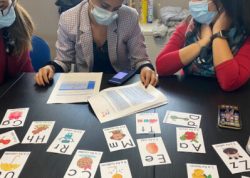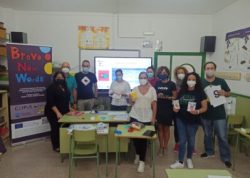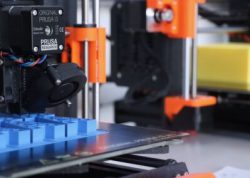What was the main purpose of the project?
“Brave New Words is a project aimed to create innovative learning pathways that increase the quality of the work of educators and staff members dealing with students with Special Learning Disorders (SpLD). We do this by using 3D printing and Augmentative Reality”, says Sonia Nociforo, Project Manager from CEIPES.
quality of the work of educators and staff members dealing with students with Special Learning Disorders (SpLD). We do this by using 3D printing and Augmentative Reality”, says Sonia Nociforo, Project Manager from CEIPES.
“The use of 3D printing and AR technology can transform how people with SpLD will learn by offering a multi-sensory experience to them. For the development of Multi-sensory methods and methodology, the new technologies (3D printing and AR) can be useful tools for developing new inclusive tools”.
How did the project foster transformative learning and values?
“Within the process of lifelong learning, the importance of individual critical and autonomous conception is demonstrated in several theories. This allows individuals to structure their own critical core and aims of autonomy from the experience they gain on the subject within the working environment. This is the basic way in which transformative learning is thought; to argue that having a critical capacity of one’s own design experience, in terms of professional placement, produces greater resilience in the subject.
Throughout the project’s implementation, various activities were carried out that allowed the whole team to experiment with different ways of using the two technologies: 3D printing and AR. For this reason, we think it is important to repeat this way of managing activities within the project.
team to experiment with different ways of using the two technologies: 3D printing and AR. For this reason, we think it is important to repeat this way of managing activities within the project.
The activity that we would definitely do again is to have a direct approach with those who help and support kids with SpLD every day. This is the right way to see an improvement in their personal path. One aspect that we would like to analyze for the future to do it in a different and better way is to have a different approach for those who will then directly use the exercises as support, then the guys with SpLD”.
What was the best practice learnt from this project that you want to share?
“The best practices that we have developed vary. We start with the design of the exercises in 3D and Augmented Reality, by including the whole consortium of the project in the test in order to analyse the needs of the target group. In addition, the transferring skills sessions of 3D printing and how to use apps for AR was another important practice. Then, the staff of the Centro Polifunzionale Si.Da, used and exploited the exercises in 3D and AR for therapy sessions to children to make them more capable of learning school subjects. Our intention was to make the learning sessions easier, but most importantly more productive”.
Augmented Reality, by including the whole consortium of the project in the test in order to analyse the needs of the target group. In addition, the transferring skills sessions of 3D printing and how to use apps for AR was another important practice. Then, the staff of the Centro Polifunzionale Si.Da, used and exploited the exercises in 3D and AR for therapy sessions to children to make them more capable of learning school subjects. Our intention was to make the learning sessions easier, but most importantly more productive”.
Text: Dimitra Kladia, EAEA
Photos: Brave New Words
Text: Dimitra Kladia I EAEAPhotos: Brave New Words

